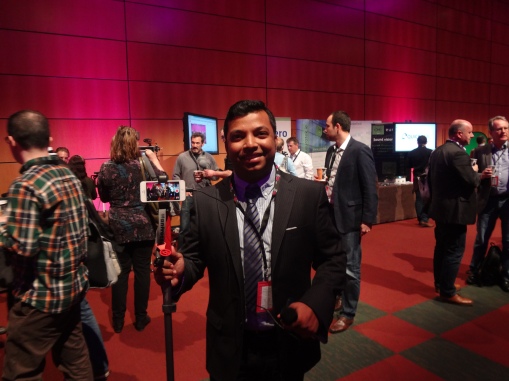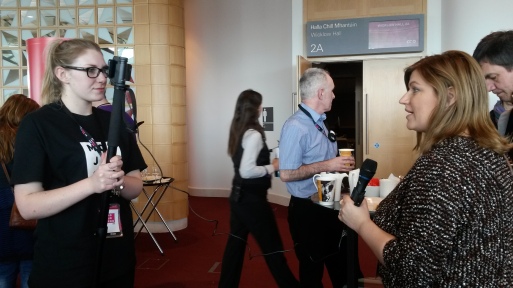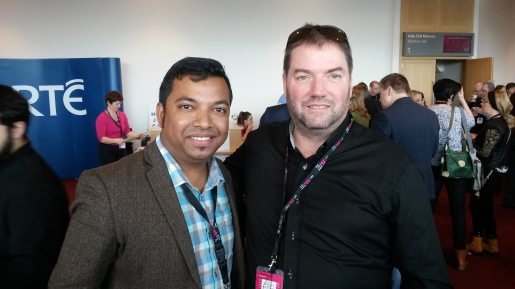 |
| At Mobile Journalism Conference in Dublin. March 2015 |
The year 2015 saw several exciting stories
hitting the huge engagement of citizen journalists. From South Africa
to Bangladesh, Mobile Journalism or MoJo more or less was practiced by
mainstream media in 2015. We observed many important stories which were covered
only with smartphone.
MoJo opened more opportunities for citizen journalists
to tell their untold stories. Some of the greatest stories that covered my
mobile journalists around the world were: #ParisAttacks (France) #PutinPresser
(Russia) #FeesMustFall (South Africa) #MigrantCrisis
(Syria) #NepalEarthquake (Nepal) #Ferguson (USA),
#WarCrimesTrial (Bangladesh) #UKfloods (UK).
Smartphone is the
perfect device to capture, edit and then instantly distribute the multimedia
content to around the globe especially during the breaking news
event. Mojo is an innovative form of reporting where people use only
a smartphone to create and file stories. As more audiences are consuming
journalism on mobile so traditional broadcasters are now hiring journalists and
mobile editors who can make and file stories with selfie sticks and
microphones.
2015 made a
place in the history of global mobile journalism. MoJoCon, the first international
media conference focusing on mobile journalism, mobile filmmaking, mobile
photography and new technology that happened in march 2015 in Dublin, Ireland.
The conference brought together many MoJo experts and mobile filmmakers from
different countries of the world. Glen Mulchey who can be called a MoJo Guru, did
tremendous job for organizing such a successful event. Like me & many other
young journalism educators and journalists were highly inspired by the speakers
and participants of the conference.
 |
| Opening session of world'd first MoJo conference |
I believe that with the
continuous development of digital storytelling tools and sophisticated apps
that will bring Mobile Journalism and Digital Media to the next level in 2016.
Western experts have already told us that next generation newsroom will
be created according to the work-flows of mobile journalism (MoJo) and VR.
Allissa Richardson who teaches
journalism at Bowie State University said her predictions for journalism 2016:
‘Mobile journalism goes virtual in 2016. It will be immersive, engaging and
empathetic.’
Raymond Joseph, a former
fellow at ICFJ Knight International Journalism Fellowships tweeted that ‘:
‘Forget digi first, now is the time of mobi first.’
Jane
Singer, professor of journalism innovation at City University
London, believes 2015 was the year media organizations have started thinking of
mobile "not just as an extension of the web but as a whole different
beast."
For me MoJo or Mobile
journalism means "everything is content." It’s a form of telling
stories faster, cheaper and reach to the bigger audience. With a multimedia
mindset, right use of the art of smartphone and
a little train can make any smartphone user to a mobile journalist.
In 2015, I covered a number
of stories which were filmed, edited and distributed with smartphone. As
hardwires, I use Samsung Galaxy mega 6.3, AV-JEFES Lavalier (Lapel)
Microphone, VJ Mini Tripod, VJ Holder (VJ-H01), VJ Firefly LED Light (to provide direct
lighting at night).
There are number of apps
available at the Android market for mobile journalism. Some apps are highly
recommended by the Mojo experts. To broadcast Live video stream, Skype still
remain the best choice for me. I use native camera app for filming and ‘Kinemaster’ app for editing. ‘Soundcloud' that I use to record voices and publish audio content. Camera360 Ultimate, Instagram and PhotoGrid use
mainly to capture still photos, annotating
or editing images and publishing them
from mobile phone.
Here I narrowed down the
top stories of 2015 which I covered by smartphone:
#VictoryDayCelebrations
#RussianPatrioticMuseum
#TradeFairinMoscow
#ProspectMiraMosque
#BangladeshFestivalinMoscow
#TributetoMichaelJackson
#RoadsUnderWaterinMoscow
#AfricanWeekatPFUR
#CrimeaBacktoMotherland
I
think it’s the time to train everyone of news outlet to become a mobile
journalist. The magic does not happen without a mindset of digital storytelling
skills and proper training. To realize the importance of mobile journalism for
today’s newsroom, in 2015, I launched ‘Smartphone Journalism Institute’ which is an online platform of learning mobile journalism.
Anyone who wishes to learn about the basics of mobile journalism can get
practical knowledge on how to capture news video or special moments of any kind
of events and interviews, use of basics MoJo apps to publish media content to
your news channel, social networks or blogs.
As a proud member of global MoJo
community, I'm very
much excited to see more positive developments in the field of Mobile
Journalism in 2016. We are looking forward to hear new MoJo voices from
every corner of the global village that definitely will encourage many
others to become a Mobile Journalist.
Happy New Year 2016!
Jamil Khan
Lecturer
Department of Mass Communications
Peoples' Friendship University of Russia
inb.moscow@gmail.com
Lecturer
Department of Mass Communications
Peoples' Friendship University of Russia
inb.moscow@gmail.com














